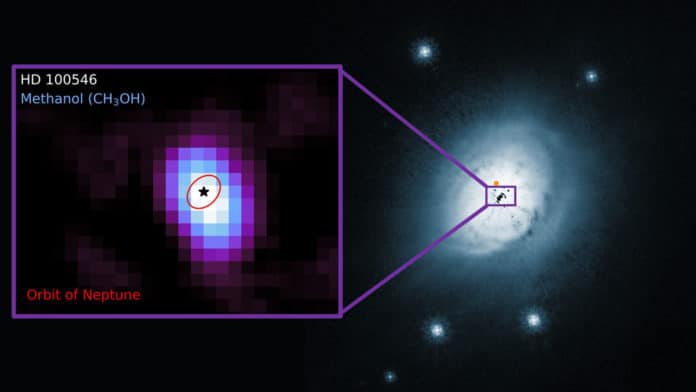Methanol, CH3OH, is one of the simplest complex molecules. It is considered a precursor for the pre-biotic chemistry fundamental for life since it tends to form, for instance, amino acids and proteins.
Previously, scientists have reported methanol in one cold planet-forming disk around a nearby star, in comets, and in the cold gas clouds from which stars form.
But now, for the first time, methanol is discovered in a warm planet-forming disk.
An international team of researchers led by Alice Booth (Leiden University, the Netherlands) has discovered methanol in the warm part of a planet-forming disk. According to scientists, methanol cannot have been produced there and must have originated in the cold gas clouds from which the star and the disk formed.

Scientists proposed that methanol ice was already present on the dust grains in the cold gas cloud from which the star and the disk originated.
Research leader Alice Booth (Leiden University) said: “This is a fascinating and surprising result. While warm methanol has been detected in the warm, young disks, because of the nature of this disk, this is the first clear observational evidence that complex organic molecules can be ‘inherited from the earlier cold dark clouds phase.”
The observations were made on the planet-forming disk around the much-studied star HD 100546, that located about 360 light-years from Earth in the direction of the southern constellation of the Fly (Musca).
Scientists made this discovery accidentally. They were looking for the simple molecule sulfur monoxide but got surprised after detecting methanol lines in their spectra.
In the future, scientists want to collect more data to observe the methanol lines at higher spatial resolution. They are also planning to look for more complex oxygen-containing molecules such as dimethyl ether (C2H6O), methyl formate (C2H4O2), and acetaldehyde (C2H4O).
Journal Reference:
- An inherited complex organic molecule reservoir in a warm planet-hosting disk. By: Alice S. Booth et al. In Nature Astronomy, 2021. DOI: 10.1038/s41550-021-01352-w
